Inuvialuit Piuyausiat Northern Games Tutorials
One Hand Reach One-Foot High Kick
Alaskan High Kick
Swing Kick

Wrist Hang
Toe Hang
Ear Pull
Kneel Jump
Two foot Low kick & Stick Twist

One Hand Reach One-Foot High Kick
Alaskan High Kick
Swing Kick

Wrist Hang
Toe Hang
Ear Pull
Kneel Jump
Two foot Low kick & Stick Twist

We have all marveled at the dexterity and strength of Traditional Inuit Northern Games athletes. What sets the Northern Games apart from other sports is the prioritizing of friendship over competition. Northern Games athletes Kyle Kuptana, James Day and their coach Donald Kuptana bring to us the Northern Games Series in Tusaayaksat – in each issue we will introduce and share how to play an Inuit Game. Here’s the first of our Northern Games Series, the gravity defying One Hand Reach!

words by Northern Games Society + James Day + Zoe Ho
photos by David Stewart

The One Hand Reach is a ‘mind game’ that tests physical strength, sense of balance and ability to focus. The athlete has to try for optimal body control, aligning his handelbow-upper arm-shoulder line on the supporting side.

To start the participant comes into a kneeling position.
Lean forward and using your legs find your center of gravity, lift the body o the floor and shift your weight to balance on your left hand.
Slowly, with control, reach the other hand up to touch the target.

Once the target has been touched, move the hand back to the floor with control.
You will maintain balance on two hands, keeping your legs and the rest of your body o the ground for a few seconds to demonstrate clear balance and control.





 For right handers, your left elbow is positioned on your left hip with the left hand flat on the floor, thumb pointing back.
For right handers, your left elbow is positioned on your left hip with the left hand flat on the floor, thumb pointing back.

Words by Northern Games Society, and extracted from Arctic Sports Training and Resource Manual photos by David Stewart

The One-Foot High Kick is an agility game. It is traditionally played indoor with groups who gather during the dark days of the winter months. It combines power (‘explosive strength’) and a high degree of coordination, flexibility and body control and is one of the most challenging Inuit Traditional Games. Traditionally the OneFoot High Kick is played by young men in the prime of their strength. They were anxious to perform well during competitions that were held at the great feasts and gatherings. Many of them would train for these events throughout the year.
 Kyle Kuptana demonstrates the One-Foot High Kick.
Kyle Kuptana demonstrates the One-Foot High Kick.

Lower body by flexing knees to about 90 degrees, plant feet and backswing arms.


Hop up to push o , extend body and swing arms overhead.


Immediately initiate kick by bending knee of kicking leg to chest in order to strike target.
As you kick the target, try to get hands, and kicking foot to almost the same level.
Recovery: Move kicking leg downwards rapidly and rotate arms upwards.







The Alaskan High kick is an agility survival game, first brought to the Northwest Territories by Alaskans visiting family here. This game was played at family camps in the Beaufort Delta, and at New Year gatherings. It was a way to showcase the agility and strength of young hunters.
The Inuvialuit passed on Northern Games as training tools for survival in the challenging arctic environment. Elders demonstrated agility games through young hunters, emphasizing proper techniques and attitudes. The games were also a fun way to socialize and to introduce new family members. The Inuvialuit adopted the Alaskan high kick, making it a Northern Games event in both male and female categories.
Lift hips high
Traveling to the Beaufort Delta region from Alaska took weeks and sometimes months. Families needed to be mentally and physically strong. Agility and confidence was crucial. Playing agility games helped build resilience and strength to endure long distance travel for successful hunts.
The Canadian record for the Alaskan High Kick is 7 feet 4 inches held by Matthew Anikina from Tuktoyaktuk. The world record is 7 feet 10 inches held by Jesse Frankson of Barrow, Alaska. The goal in agility games is not to make or break records, but to develop skills and patience.
Stack shoulders
 James Day demonstrates the Alaskan High Kick
James Day demonstrates the Alaskan High Kick
In this demo, we are showing lower kicking heights for kindergarten to 8th grade students. Kicking heights start at 10”–18”.

Note: The right foot is the kicking foot here. If you kick with your left foot, reverse the instructions for left and right.


Visit our Tusaayaksat Facebook page for an online instructional!


Watch Inuit Games at the Canada Winter Games on Youtube http://www.youtube.com/ watch?v=kkZQ7b22A8Q


Words by Northern Games Society photos by Nathalie Heiberg-Harrison

Rock hips forward
Swing feet up

The swing kick is a game of agility. It develops an individual’s strength, quickness and body control. The objective of the game is to position your body in between your arms while sitting on the floor, and then balance on your hands with a belt looped around your knees and neck. Swinging your body back and forth like a pendulum, you aim to hit a seal target with both your feet and then land softly back on the floor. This game helped hunters develop good balance and core body strength.

To start, the participant sits on the floor with both knees bent, positioned together, and their feet flat on the floor. A belt is looped around both knees and placed around the neck. Their head should be approximately 3’’, or a fist-length, from their knees.




The participant lifts themselves o the floor, balancing their body so they have a good centre of balance with legs stretched out, feet together and toes pointed forward.

Once the participant has hit the seal target they will maintain balance with only their hands touching the floor.
To finish, the participant touches their feet, and then their entire body, back to the ground.

The wrist hang is an Inuit game of pain resistance. Elders introduced the resistance to pain games specifically to deal with freezing conditions Inuit faced daily. Both men and women had to build their own endurance to the demands of living in the Arctic. These pain resistance games mimicked the Arctic weather conditions and enabled Inuit to tolerate the freezing weather conditions from snow and winds. In these extreme Arctic conditions, freezing your face, ears, hands and feet were common.

Words by Northern Games Society
Photos by Nathalie Heiberg-Harrison
 James Day Jr. demonstrates the wrist hang
James Day Jr. demonstrates the wrist hang
There are three variations to the wrist hang practiced today: male, female and youth. Below, James Day Jr., Courtney Larocque and Donald Kuptana demonstrate the youth wrist hang


For a further challenge, the handlers stay in place and lift the stick to shoulder level.



 To start, the participant sits on the floor with his or her legs crossed.
The participant lifts himself or herself o the floor and above the stick.
The handlers hold the stick level with the top of the participant’s head.
The handlers walk forward for a distance. In competition, participants are judged by having the proper form for the longest distance.
The participant grips the stick with both hands.
1.
4.
5.
6.
2.
3.
To start, the participant sits on the floor with his or her legs crossed.
The participant lifts himself or herself o the floor and above the stick.
The handlers hold the stick level with the top of the participant’s head.
The handlers walk forward for a distance. In competition, participants are judged by having the proper form for the longest distance.
The participant grips the stick with both hands.
1.
4.
5.
6.
2.
3.
The participant straightens their legs forward and parallel to the ground to enhance core strength.



For a further challenge, the participant lowers himself or herself from the stick, making sure to not touch the ground.

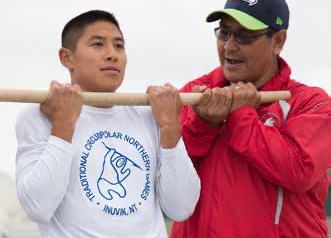
Then, the participant pulls himself or herself back above the stick.
To finish, the participant lowers himself or herself back to the ground.
The participant returns their legs to the starting position. 7. 8. 9. 10. 11.Words by Northern Games Society
 Photos by Nathalie Heiberg-Harrison
Photos by Nathalie Heiberg-Harrison
The toe hang is an Inuit game of pain resistance. It is meant to mimick the feeling of frozen feet that one would experience on the land in the fall, winter and spring. Both men and women had to build their own resistance to the demands of living in the Arctic, and these pain resistance games enabled them to better tolerate the ice, wind and snow. For example, if a hunter’s feet got wet while on the ocean and they were a great distance from their camp, they would need to endure the pain of frozen feet to make it back safely.
 James Day Jr. demonstrates the toe hang with help from Courtney Larocque and Donald Kuptana.
James Day Jr. demonstrates the toe hang with help from Courtney Larocque and Donald Kuptana.
The participant who goes the furthest distance or hangs for the longest period of time, enduring the most pain, is declared the winners of toe hang. There are no di erences in techniques used between male and females in this game. The game begins when the participants lays on their back, with two handlers at their side ready to lift them.
 The participant will position themselves under the stick with their legs stretched out and feet positioned above the stick.
The participant will position themselves under the stick with their legs stretched out and feet positioned above the stick.
The participant will position their toes to grip the stick to be lifted. The participant will tighten all of their muscles and position their head as close to the legs as possible. On their go, their handlers will lift them o the floor with only their toes gripping the stick to hold them up.


Once lifted o the floor the stick handlers will walk forward for a distance. The participant also has the option of hanging for a time.
 The participant will wrap both arms around their legs behind their knees linking their hands.
2.
3.
4.
The participant will wrap both arms around their legs behind their knees linking their hands.
2.
3.
4.

Ear pull is an Inuit game of pain resistance. It is meant to mimic the feeling of frostbite to your exposed extremities such as your ears, forehead, cheeks and hands. Checking shnets, skinning caribou, running with your dog teams and playing outside for long periods of time were common experiences in the wintertime. Our Inuvialuit ancestors had to build their own resistance to the demands of living in the Arctic, and the pain resistance games enabled them to better tolerate the ice, wind and snow conditions.

 Underwood Day demonstrates the two-foot low kick.
Words by Northern Games Society
Photos by Nick Westover
Underwood Day demonstrates the two-foot low kick.
Words by Northern Games Society
Photos by Nick Westover

 Underwood Day and James Day Jr. demonstrate the ear pull
Underwood Day and James Day Jr. demonstrate the ear pull
2 3 72 26
1
The participants position themselves on their stomachs, facing each other, while resting their forearms in front of their bodies.

The participants wrap a loop of string around their ears, making sure they are in the same position as their partner with the string parallel to the ground.
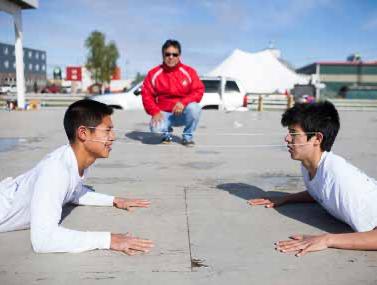

4
The participants’ hands remain in the same position, and the string remains parallel to the ground. They keep their bodies straight like a plank.

5 6
Once lifted o the oor, the participants move back on their hands and toes and can widen their stance for stability.
Participants continue to pull on the string with the goal of pulling the string o their partner’s ears, while resisting the pain in their own ears. The participant who nishes with the string on their ear is the winner.




Kneel jump is an Inuit game of strength passed on from generation to generation. When on the land, hunters need to be physically and mentally prepared to react quickly and swiftly to their changing surroundings. They need to be able to jump up and into action, jump across cracks in the ocean ice, or react in an instant to get themselves out of harm’s way. The kneel jump prepares them for anything that can happen.
 Words by Northern Games Society
Photos by Nick Westover
Words by Northern Games Society
Photos by Nick Westover


 James Day Jr. demonstrates the kneel jump.
James Day Jr. demonstrates the kneel jump.
All in one motion, the participant uses their arms to propel their body upward and forward, keeping their body and toes straight.


After leaping forward, the participant should land on their feet in a squatting position.

 Participants begin on their knees, sitting at on their shins, with their feet at on the ground.
Their knees should be tight together with their arms at their sides.
Participants begin on their knees, sitting at on their shins, with their feet at on the ground.
Their knees should be tight together with their arms at their sides.

3 7
4 8


 Participants begin by swinging their arms forward in a pendulum motion to gain momentum and speed.
The participant’s knees should remain on the ground while they lean forward and move their body upward.
The participant should land at on their feet, without a bounce, and with their feet shoulder width apart.
The distance between the start line and the back of their heel is measured while they stand straight up. The participant who nishes the furthest from the start line is the winner.
Participants begin by swinging their arms forward in a pendulum motion to gain momentum and speed.
The participant’s knees should remain on the ground while they lean forward and move their body upward.
The participant should land at on their feet, without a bounce, and with their feet shoulder width apart.
The distance between the start line and the back of their heel is measured while they stand straight up. The participant who nishes the furthest from the start line is the winner.
The two-foot low kick is an Inuit game that challenges participants to be quiet and light on their feet – an important skill while hunting on the land. In competition, participants encourage each other to kick further and further out while also landing lightly on their feet. This event is a demonstration game used to warm up athletes, but is not used in competition. As always, the main point of the game is to have fun and do your best.
 Words by Northern Games Society
Photos by Nick Westover
Underwood Day demonstrates the two-foot low kick.
Words by Northern Games Society
Photos by Nick Westover
Underwood Day demonstrates the two-foot low kick.


1 2
They balance on their toes and bounce slightly to gain momentum.


Northern Games &
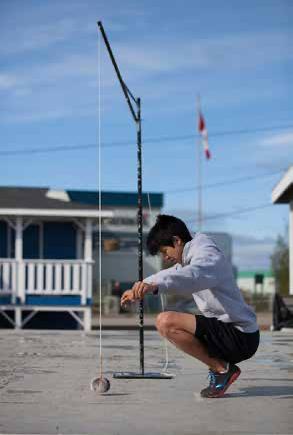 Participants begin in a standing position.
Participants begin in a standing position.
4 5 6
Next, participants kick the ball with their toes stretched out straight.
Afterwards, they bring their feet back to the starting position, landing lightly on their toes.

As a challenge, the ball is placed further and further from the starting point. The participant who kicks furthest from the starting point while also landing back on their toes is the winner.


Words by Northern Games Society
Photos by Nick Westover
Stick twist is an Inuit game that tests a participant’s muscle memory. It is meant to teach the movements of their body and instill con dence in those that practice it. As always, the main goal is to have fun and try your best!

 Underwood Day demonstrates the stick twist.
Underwood Day demonstrates the stick twist.
Participants begin in the standing position with the stick beside them. (It should reach to the top of their stomach.)






Next, they put the stick behind their back, holding it loosely with their ngers.
4 6
They raise the stick above their head with both arms.
1 2 3 5
Beginning
Next, they bring the stick in front of their bodies with their hands twisted backwards. They move the stick in between their legs.
They lift their right leg over the stick.
7 10 11
8 9

Next they stand holding the stick in front of their bodies. To complete the stick twist, participants then reverse the steps, beginning with their left foot this time.
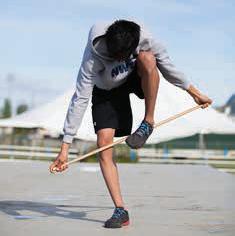

Then they move the stick around their hip and over their back, guiding it with their left arm.
They lift their left leg up and over the stick.
Participants nish in a standing position with the stick behind their back.


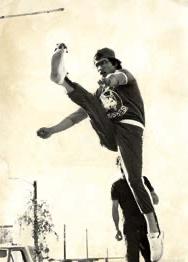

The Traditional Inuit Northern Games were originally developed to help Inuit survive harsh weather conditions. Pain and resistance games mimicked extreme cold and freezing weather conditions so that endurance could be built up for real life survival. Imagine travelling from camp to camp or out hunting in minus 50 degree celsius temperatures, with 35 km per hour windchill – being prepared is a good idea!
The Northern Games strengthens the bonds of families and communities all across the Arctic regions as they come together to celebrate and play. The Games embody the spirit of friendly competition. Elders would always emphasize to participants the importance of trusting and supporting each other.
Traditionally and today, everyone participating and watching supports your best e ort at the games. It does not matter how high you kick or how strong you are. These games are fun and help to keep everyone physically and mentally fit for survival on the land.
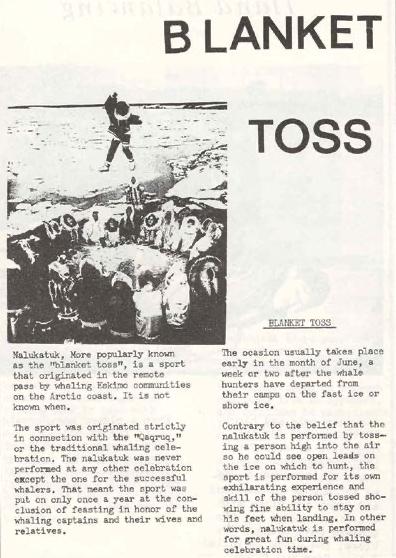
Pain Resistance games:

The Inuit Elders introduced pain resistance games to teach young hunters to have immunity to pain in cold and freezing weather conditions. Cold weather conditions were a fact of life while hunting on the land or ocean and a hunter has to be prepared against the pain of frostbite on his face, ears, hands and feet in order to continue hunting
Strength Endurance games:
The Inuit Elders introduced games for building strength and endurance. These games prepare you for the stamina needed for long distance travelling, especially in the fall and winter. In the summer families would travel from camp to camp following the food sources, carrying only what they could.
Agility games:
These games were developed for young hunters to deal with di erent challenges when travelling in every season. Youth challenge each other to see who can be the most quiet, especially on landing after kicking/ touching targets placed at challenging heights. These are necessary hunting skills that mimic the stealth needed to approach animals quietly while hunting
Social games:
The social games are “laughing games” that keep people socially active and engaged. These fun games were traditionally played during blizzards, long dark winter months and at gatherings. “Animal Muk”, “Team Animal Muk”, “Oneon-one laughing Muk” and the “Group Ghost Game” are some of the most popular laughing games and are still played today.
Blanket Toss (Nalukatak) was originally thought to be performed so a hunter could see open leads on the ice for hunting. It is also thought of as a social game, to celebrate success in whaling Dwayne Illasiak competing in Knuckle Hop, a pain resistance and strength building game (Canada Winter Games). Harpoon throw was a game that trained the hunter for greater accuracy. John Day in one foot high kick. (ICS Archives)